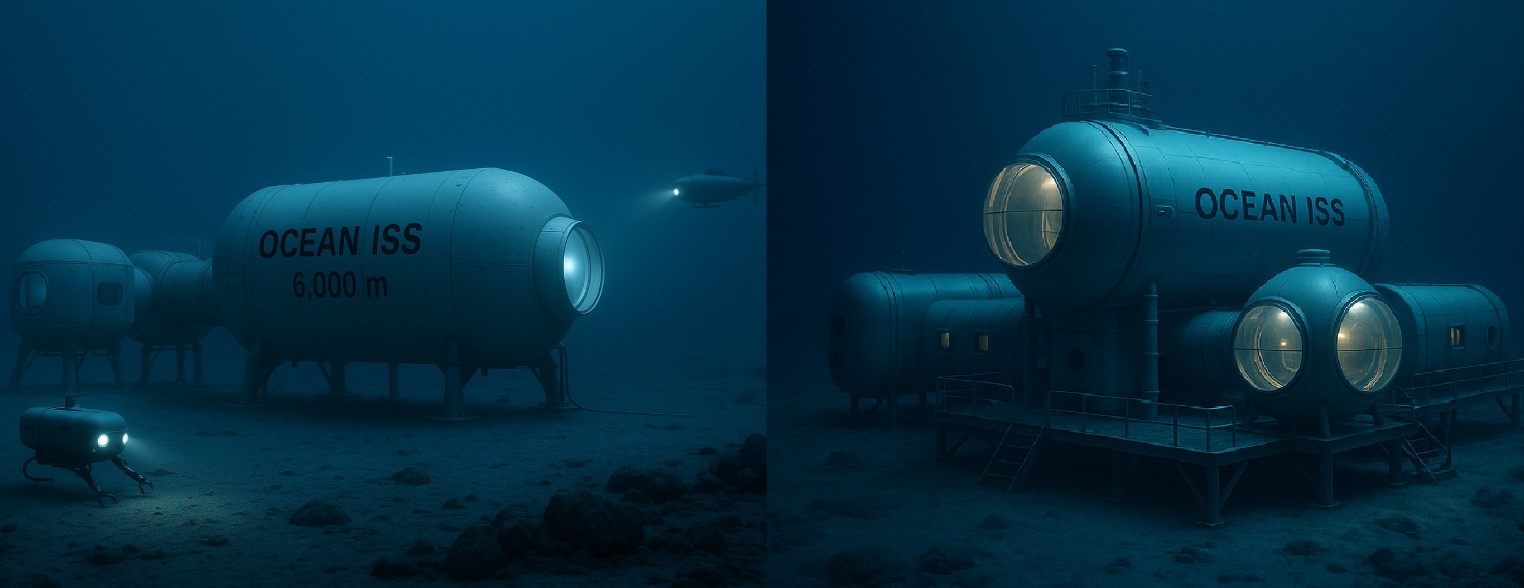India Plans World’s Deepest Underwater Lab ‘Ocean ISS’ at 6,000 Metres

When India’s ocean scientists talk about the deep sea, they describe it with the same excitement that astronomers use for distant planets. Except this world is not light years away — it begins just a few kilometres under the waves. Now, India is preparing to go deeper than any nation has ever lived or worked before.
In an ambitious leap under the Deep Ocean Mission, the National Institute of Ocean Technology (NIOT) has begun shaping plans for a permanent underwater research laboratory at 6,000 metres depth — a place so extreme that sunlight never reaches it, temperatures hover near freezing, and pressure is more than 600 times what humans feel at the surface.
If completed, this would be the deepest underwater lab in human history — a kind of “Ocean ISS” anchored to the seafloor of the Indian Ocean.
A Vision That Begins in the Darkness
The idea did not appear suddenly. For years, Indian researchers have mapped seafloors, sent robots into trenches, and built prototypes of pressure-resistant spheres in workshops in Chennai. Slowly, the dream formed:
If astronauts can live above Earth for months, why can’t aquanauts live beneath it?
The initial steps are already underway. NIOT is testing a 500-metre demonstration habitat, a smaller module meant to teach engineers how to handle life support, pressure, communication and docking systems. Only after this will India attempt the bold jump toward 6,000 metres, where every detail — every weld, every cable — must be engineered for a world that crushes anything unprepared.
This future habitat will likely be a cluster of titanium and composite modules, interconnected like a space station, with observation ports, laboratories, crew quarters and docking points for submersibles like Matsya 6000, India’s soon-to-be flagship deep-sea vehicle.
What Life Looks Like Six Kilometres Down
At 6,000 metres, humans have barely spent minutes — never days, never weeks. But India’s proposed lab aims to change that. If scientists live there, their work could transform our understanding of Earth.
Studying Life That Shouldn’t Exist
The deep ocean hosts creatures that look almost alien — transparent fish, luminous worms, pressure-loving microbes. Observing them long-term could explain how life survives without sunlight and whether similar forms might exist on icy moons like Europa or Enceladus.
Unlocking the Microbial Frontier
India is already building a Deep-Sea Microbial Repository, and a 6,000-metre lab would feed it with samples found nowhere else on the planet. These microorganisms may help create:
-
new antibiotics,
-
powerful industrial enzymes,
-
eco-friendly plastics breakdown systems,
-
and even skin-care or medical compounds evolved for life under crushing force.
Watching the Earth Shift From Below
A lab this deep could sit near tectonic activity — the massive, grinding edges of Earth’s plates. Instruments around it could:
-
track micro-earthquakes,
-
measure seafloor movement,
-
study hydrothermal vents,
-
and help understand how tsunamis begin.
Tracking Carbon and Climate in the Abyss
Most of Earth’s trapped heat and carbon ends up in the deep ocean. A permanent habitat would finally give scientists long-term, real-time data on how the deep sea responds to climate change — a mystery that climate models desperately need solved.
Who Else Has Tried — and How India Goes Beyond Them
Underwater laboratories are not new, but none comes remotely close to India’s dream.
-
Aquarius Reef Base in Florida sits at only 19 metres — it is the world’s only functioning undersea lab today.
-
Proteus, being built by Fabien Cousteau, will also be at shallow depth — around 20 metres, with deeper satellites reaching about 70.
-
The UK company DEEP is working on habitats around 200 metres, suitable for continental shelf science.
The only project that hints at going deeper is China’s planned deep-sea station at about 1,800 metres — still far from India’s planned 6,000 metres.
In other words, no nation has ever attempted a liveable lab in the hadal zone. India would be the first to step into that darkness for real.
Engineering at the Edge of Survival
Nothing about a 6,000-metre habitat is ordinary. India’s engineers are preparing for challenges that few have even studied:
-
Pressure so high that one small flaw could instantly collapse a structure.
-
Communication delays caused by sound traveling unevenly in deep water.
-
Power lines that must stretch kilometres through rough ocean, without breaking.
-
Life-support systems that must run flawlessly for weeks in a place no human can step outside to repair.
The materials alone — from the titanium hulls to the special acrylic viewports — must endure forces we rarely encounter on Earth.
This is why the mission is long, why the target year is near 2047, and why every test, every dive of Matsya 6000, every simulation matters.
More Than Science: Why This Matters
If India succeeds, its underwater lab will not only unlock deep-sea secrets — it will shift global scientific leadership. A functioning station at 6,000 metres would make India a pioneer in high-pressure engineering and ocean technology, while giving the country a major push in the blue economy through breakthrough research in biotechnology, advanced materials, and deep-ocean minerals.
It would also sharpen the world’s understanding of natural hazards by improving tsunami prediction systems and long-term climate models based on real data from the abyss. At the same time, the habitat would serve as a testing ground for future exploration beyond Earth, helping scientists study how humans adapt to long-duration life in isolated and extreme environments — knowledge crucial for Moon and Mars missions.
Most importantly, such a station would finally open access to the last great frontier on the planet, a realm still more mysterious than Mars and more unexplored than the Moon.
A New Era Beneath the Waves
In the coming decades, when the first team of Indian aquanauts descend to live in this extreme, silent world, they will not just be exploring the deep sea — they will be revealing an entire hidden planet that has existed beside us, untouched, since the beginning of time.
If space is humanity’s upward journey, then the deep ocean is its inward one.
And India is preparing to lead that journey into the darkness, to a depth where no country has ever dared to build a home.
✍️ This article is written by the team of The Defense News.





